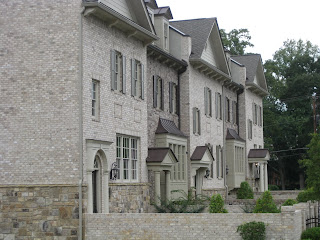 Atlanta, Georgia does not have any neighborhoods that look just like Levittown or Lakewood. However, the city does contain many examples of one of the biggest complaints the previously stated mass-produced suburbs received: conformity.
Atlanta, Georgia does not have any neighborhoods that look just like Levittown or Lakewood. However, the city does contain many examples of one of the biggest complaints the previously stated mass-produced suburbs received: conformity.Conformity was an issue in many of the postwar developments as individuality and uniqueness disappeared into the clear-cut landscape. In 1962, Malvina Reynolds critiques suburbia with the song Little Boxes. She sings not only about identical houses but identical people and lifestyles as well. The lines "And they're all made out of ticky tacky, And they all looked just the same" resonates the issue of mass conformity with the audience.

The two photographs above are of a townhouse development in Brookhaven. While the construction of the remainder of the units has been delayed by the economy, it is evident in these four units that the neighborhood will echo the “ticky tacky” characteristics that Reynolds wrote about.
While in the beginning conformity was introduced by developers, it was embraced and later encouraged by homebuyers. This adoption to conformity has led to neighborhoods such as the one in Brookhaven being constructed today.
Middle-class suburbs are not the only housing units that conform to a mold. Worker housing can also be “ticky tacky,” but challenge the other verses of Reynolds’ song. While the residents of worker housing will not be playing “on the golf course” or drinking “their martinis dry,” they will live in houses that “all look just the same.”
The photos below are of double shotgun row houses (Auburn and Boulevard) constructed for workers of the Empire Textile Company in 1905. While they came before the postwar housing boom, they illustrate the same principles of conformity that echo throughout Reynolds’ famous song.


I'd have loved if you *had* found a postwar section of town with identical (or once-identical) houses, but I like that you moved forward and backward in time to come up with these examples that illustrate the same. What does the persistence of visual homogeneity suggest about the critiques of postwar development such as Malvina Reynolds's?
ReplyDelete